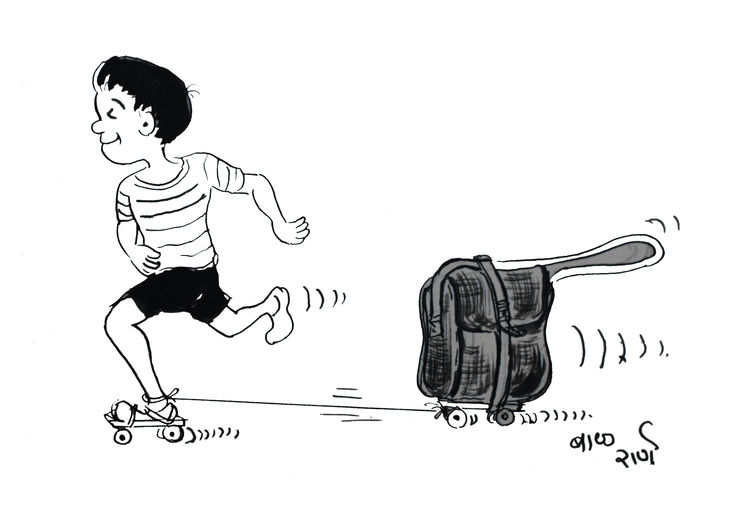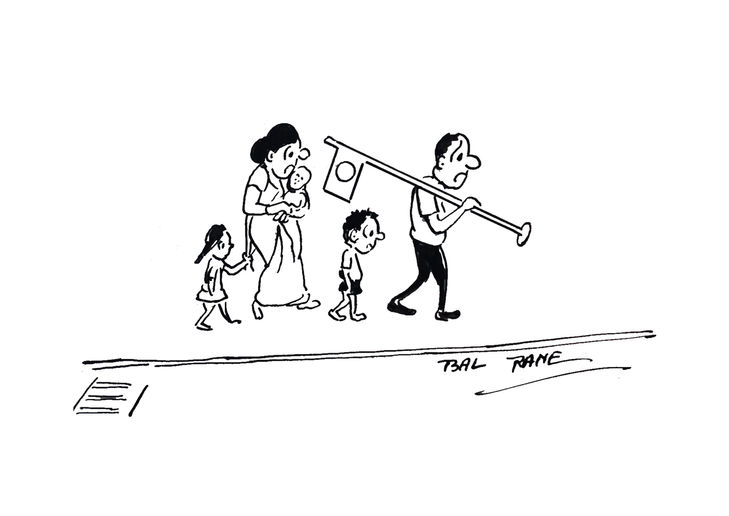
BAL RANE (VETERAN CARTOONIST)
A retrospective exhibition of 12 eminent cartoonists including Balasaheb Thackery, Vasant Saravate, Vikas Sabnis and Shyam Joshi was curated by Nehru Centre Art Gallery between 15th December 2022 to 1st January 2023 which also featured Bal Rane. When one comes across Bal Rane’s cartoons, it is quite hard not to be entertained. Very popular among readers from the 1940s through the 80’s, his cartoons often depicted hilarious situations relatable to the Indian middle class. The relatability quotient and the relative ease, using a few strokes and dots, with which he conveyed the message of finding humour in any situation made him a household name among Marathi, Gujarati, and English magazine and newspaper readers.

Born on January 26, 1914, in the village of Janvali, near Kankavali in Konkan, Bal Rane had always aspired to become a painter. Growing up in picturesque surroundings, he found his initial muse in nature. One of the first awards he received was from the Art Society of India for a landscape painting using two mediums of water colours and dry pastels. It was a passion that he would arduously follow throughout his life. He became the first person from his village to complete his high school education, and travel to Mumbai in search of a livelihood. There, he took up a clerical position at the police commissioner’s office and simultaneously trained under the famed painter S L Haldankar to learn the art.
Despite his work obligations, he always found time to hone his passion, in fact, the first thing he did in the mornings before going about his day was to practise drawing cartoons for an hour and a half. He always carried a comic book around with him and when inspiration struck, even a bus ticket became his canvas. Of the many contemporaries of his time, he looked up to Balasaheb Thackeray, Sarvashree Shankar, S. D. Phadnis, Borgaonkar, Dalal, R. K. Laxman, Mario Miranda, Vikas Sabnis, Dnyanesh Sonar, and Khalil Khan. Amongst them, the works of Dalal were his favourite.
Bal Rane often participated in cartoon drawing competitions held by magazines and organisations and won several prizes. Eventually, the editor of Dainik Maratha, P. K. Atre took notice of his work and encouraged and offered him critical feedback, suggesting while his concepts were refreshing, he could improve on his lines. Taking his advice, he religiously studied cartoons drawn by various artists and developed his own style. His cartoons revolved around social, political, and everyday happenings with touches of anthropomorphism at times, and a lot of them were without captions or speech bubbles, yet successfully managed to elicit laughter from readers.

A significant change in his drawing style can be observed over the years – smoother lines, a nuanced display of various emotions with just lines and dots, and a minimalistic approach to the subject at hand. His preferred mediums were brushes, black ink, crookwell pens, and artcard papers. His cartoons were published in a wide range of Marathi magazines such as Manohar, Kirloskar, Hans, Vasant, Mohini, Udyam, Wangmay-Shobha, Ramyakatha, Vasudha, Awaaz, Janashakti, Rupa, Prabha, Shree, Marmik and Kishore. In addition, his work was a regular part of Shankar's Weekly in English, Dharmayug in Hindi, and Chitralekha in Gujarati. His pocket cartoon named ‘Balukaka’ was printed in the Marathi newspaper Tarun Bharat for almost 35 years.

Bal Rane had a dedicated and methodical approach to his work. Every day after reading the newspaper, he would set out to sketch 3 to 4 cartoons on social and political situations that warranted reader’s attention, and then mail it to the newspaper in Pune from Mumbai via post. He often fervently poured over the drawings of renowned cartoonists, studying, dissecting, and comparing them to gain thorough insight.

Apart from being an exceptional cartoonist, Bal Rane was a man of many talents. He ran a poultry farm, cultivated cashews, did taxidermy, and enjoyed cooking and creating his own recipes. He was self-taught and brilliant in every endeavour he took up. He was also skilled in playing the flute, harmonium, and violin. After retiring from his government job, he took upon a new project – learning photography. He converted his kitchen into a darkroom and spent every night experimenting with black and white pictures, developing, enlarging, and printing. He continued to do so until two or three months before his passing at the age of 68.
"He was a man of few words but always had a lot to talk about cartoons," reminisces his daughter Pratibha. They would often discuss their favourite cartoons and analyse the drawings, composition, expression, and humour when she was younger. He had wished for her to become a professor, a painter, and to hold a place among the women cartoonists in India.


Having fulfilled the first two of his wishes, and carved a niche for herself, Pratibha feels a tinge of sadness in not having followed her father’s footsteps. She has preserved around 20-25 sketchbooks of his having 200 pages each, card paper drawings, and all the published prints in memory of her father’s passion for his craft. In 2014, to commemorate his birth centenary, all of his artwork was exhibited at the Sir J. J. College of Applied Arts to welcome a new generation of artists. Pratibha has now taken it upon herself to fulfil one of his last wishes of having a selection of his cartoons compiled as a book. Like Kalpavriksha, the wish-fulfilling tree, she says that once her father’s wishes are fulfilled, her heart too shall bloom.
















